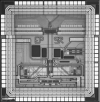Bandpass sigma delta modulation

Analog-to-digital (A/D)-convertors are essentiel building blocks in many modern electronic systems. Particularly in wireless applications, the performance of the entire system is often determined by the embedded A/D-convertor. Next to this, there is an evolution to software radio. To enable this, the A/D convertor should be as close as possible to the antenna in the receive-path. In this context, a bandpass Sigma Delta modulator is interesting. Indeed, radio-signals typically occupy a limited bandwidth, but the received signal is located at a high (intermeditate) frequency. In a traditional receiver, this signal is downconverted to a low frequency in the analog domain, but this is undesirable in the software radio concept. A solution for this is to digitize the signal band (which is located at a high frequency) directly with a bandpass Sigma Delta modulator. A more advanced technology for this is a so-called quadrature bandpass Sigma Delta modulator. This is an improved version of ordinary bandpass Sigma Delta modulation. Here, two signals are handled at the same time (i.e. the so-called I and Q components). This leads to a clear simplification of the hardware. |

One of the main problems with these modulators, is the mismatch between the different paths inside the modulator (path-mismatch). This gives rise to spurious tones. In this research, we propose architectural solutions and design efficient circuits to implement this. |
